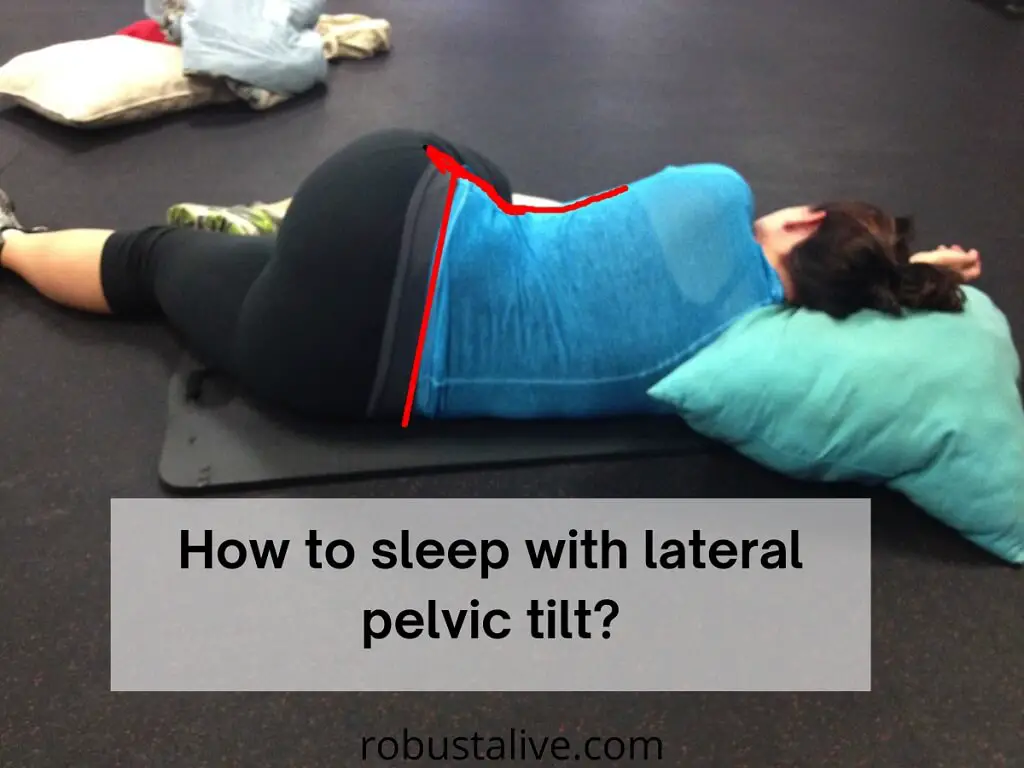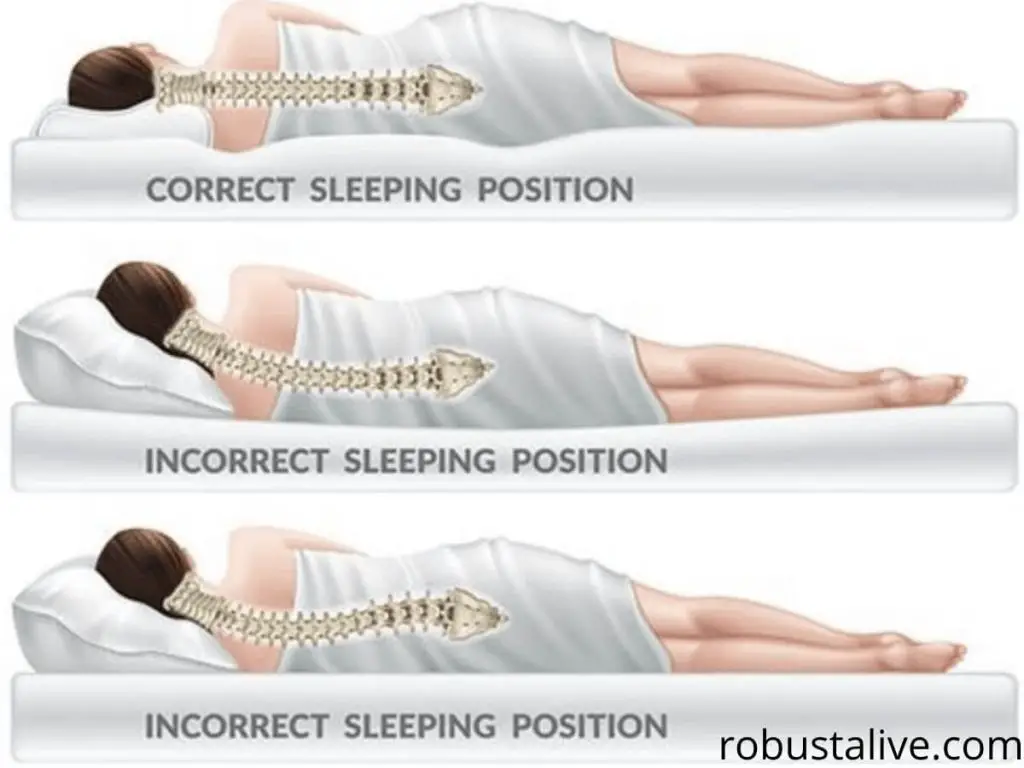How to Sleep with Lateral Pelvic Tilt?

If you have an anterior pelvic tilt, how to sleep with lateral pelvic tilt? Will your tilt go worse if you sleep incorrectly? Will it get better if you sleep in a favorable position?
We have some terrific advice for you if you have an anterior pelvic tilt, such as how to sleep to improve your alignment to the ideal position for your pelvis at night.”
Anterior pelvic tilt: what is it?
When your pelvis is towards the floor from the front, it refers to an anterior tilt. It’s not a severe orthopedic disorder. Simply put, it indicates that particular muscles are positioned in your pelvis in a less-than-ideal manner at the front.
Your lower back will develop an arch in this position, which is not ideal from a biomechanical standpoint. “Hyperlordosis” refers to this pronounced curve in your low back.
Hyperlordosis is not a severe illness or condition. It simply indicates that your lower spine is curvier than what is ideal for your hip muscles and vertebrae.
What is the neutral pelvic position?

Photo credit: robustalive.com
The position in which your hips point and pubic bone form a triangle perpendicular to the floor refers to a neutral pelvis. With this alignment, the structures of your lumber spine are under minor stress (lower back). You can control your pelvis and spine in this position to prevent compression in your low back and movement problems in your hip joints.
But everyone’s pelvic bones are unique in shape. It is almost sure to be asymmetrical if you compare the two sides of your pelvis. Because of this, it is hard to provide precise measures that are suitable for everyone. We at Upright Health believe that you should be able to stabilize your pelvis in any posture you require.
To keep your pelvis in a more neutral posture if it is already tilted anteriorly, you should engage your abs, hamstrings, and glutes without feeling like you are exerting all of your physical and mental energy.
Role of Sleeping Position in the Anterior Pelvic Tilt
When we go to sleep, we give our bodies a chance to recharge. When we wake up, we want to be comfortable and pain-free. It is entirely conceivable that many people move around when they sleep at night.
However, a lot of people favor one over the other. You can use many techniques to improve your body’s position when you sleep, regardless of whether you sleep on your back, side, or stomach. They all deal with the problem of how to correct anterior pelvic tilt while sleeping.
We could intensify or cause the anterior pelvic tilt when we sleep. Therefore, we must train ourselves to sleep in a neutral position. But how do we go about that? Put a pillow or blanket under your knees if you prefer to sleep on your back, face up, or in the supine position.
Numerous problems also result from sleeping on your stomach. What happens if you prefer to lie on your side? Exercise caution and awareness when choosing your side positions.
It’s a good strategy if you often sleep on your side and curl up into the fetal position. Adopting the fetal position, your spine or pelvis might be in a neutral or posterior tilt position.
How to Fix Anterior Pelvic Tilt While Sleeping on your Side?
The following suggested posture is to sleep on your side. Applying the adjustments above will stop an anterior pelvic tilt.
How may the anterior pelvic tilt be corrected while sleeping on one’s side? To prevent an internal shoulder rotation or falling straight to the side, keep your knees slightly bent and your arm resting underneath your pillow to maintain a neutral position.
To prevent your head from slanting to one side or the other, keep your neck in line with the rest of your lumbar region by using a pillow that is as thick as your shoulder. Place still another pillow between your knees before finishing. Your hips will stay in alignment if you place pillows between your knees.
Lastly, keep in mind that our muscles tend to constrict as we sleep. Preventing this compression by sleeping a static stretching exercise will help. You’ll feel less stiff and better prepared for the day when you wake up.
How to Fix Anterior Pelvic Tilt While Lying Down?
Sleeping is something we all do, and it initially seems pretty straightforward. But it’s easy to make mistakes.
We spend eight hours a day in this position, which can result in headaches, neck and back pain, an elevated risk of dementia, and even fine wrinkles. Because of this, it’s essential to consider it seriously and make the required modifications to sleep in your ideal position.
The pelvic region is unaffected by sleeping in bed. Those muscles that ought to be relaxing are not. It is because your pelvis can tilt further anteriorly in the bed. So, how can anterior pelvic tilt be corrected while lying at night?
When lying supine, face up, or sleeping on your back, take a pillow or blanket and put it beneath your knees. Elevating your knees will help you relax your back muscles and maintain a neutral pelvis position.
People more prone to anterior pelvic tilt (bum pointing out) naturally have a more curved lower back. Straight-legged sleeping can accentuate the lower back’s curvature and cause the joints to start to stick together.
It should be no surprise that people will be in pain if they do this for eight hours. Placing one, two, or even three pillows under your knees will address how to address anterior pelvic tilt when sleeping.
It relieves pressure by expanding the lower back joints and slightly bending the hips.
Sleeping positions to avoid anterior pelvic tilt
You don’t want to put yourself in a situation where the anterior tilt is made worse. You are encouraging an anterior tilt in case you are sleeping on your stomach, and your stomach sinks into the bed, tipping your low back into lordosis. Get your body accustomed to staying in neutral pelvic postures by finding them.
In other words, sleeping on your stomach, especially on a soft bed, will accentuate your anterior tilt.
Conclusion
Your ultimate objective shouldn’t be to spend the entire night in a tightly controlled position. Sleeping in these anterior tilt postures can train your body to locate neutral more quickly. These positions won’t wholly reverse your anterior tilt while you’re sleeping.
It would help if you gradually improved your muscles to keep your pelvis neutral to correct anterior tilt. Stretching, strengthening, and learning to manage your pelvis position may all be necessary consciously.
Exercises for anterior pelvic tilt are beneficial, but they also need to be combined with dietary changes like these to help you improve your anterior tilt inclinations all day (and all night) long!
Frequently Asked Questions (FAQs) about How to Sleep With Lateral Pelvic Tilt?
How is anterior pelvic tilt treated when sleeping?
Sleeping in these anterior tilt postures can train your body to locate neutral more quickly. These positions won’t completely reverse your anterior tilt while you’re sleeping. It would help if you gradually honed your muscles to keep your pelvis neutral to correct anterior tilt.
How can anterior pelvic tilt be quickly corrected?
Exercise stretches and massage can all benefit from correcting an anterior tilt. If your job requires prolonged sitting, remember to get up and stretch, or consider taking a stroll instead of a sit-down lunch.
How long will it take to correct anterior pelvic tilt?
According to research, anterior pelvic tilt can be corrected in as little as six weeks. But it’s vital to remember that every person is unique. Others could need more extended time, but other people might start to correct anterior pelvic tilt within a few weeks.
Why does the anterior pelvic tilt occur?
The shortening of hip flexors and extending of the hip extensors contribute to anterior pelvic tilt. The lower spine and upper back both curve more due to this. The muscles that connect the thigh bone to the pelvis and lower back are known as the hip flexors.
References:
https://www.medicalnewstoday.com/articles/317379
https://www.uprighthealth.com/blog/sleep-anterior-pelvic-tilt
https://www.healthline.com/health/fitness-exercise/anterior-pelvic-tilt-exercises
https://www.issaonline.com/blog/post/timeline-to-fix-anterior-pelvic-tilt-exercises-that-help





